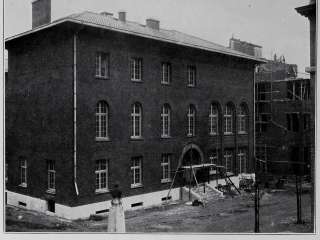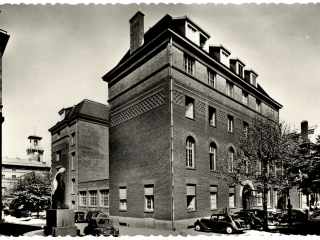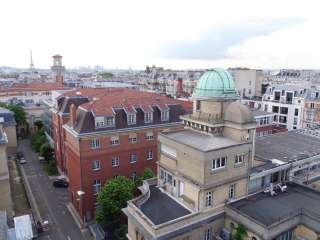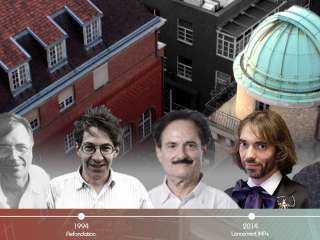In 1968, Paul Montel was still director of IHP and remained so until his death in 1975, at the age of 98! Paul Belgodère, who was in charge of the library, was also the secretary general of the institute, which he held firmly in his hands during the events of May.
It was not so much the political unrest within the walls of IHP that marked a break with the past, but the Faure Law of 12 November 1968, which confirmed the break-up of the University of Paris and consequently the disappearance of the Faculty of Sciences, of which the IHP was a part. The institute thus lost its legal existence and its operating resources.
In the 1970s and 1980s, the building was administered by the Chancellery of the Universities of Paris and its use became dispersed. Many mathematicians joined the new campuses of Jussieu and Orsay, with the notable exception of René Deheuvels, Pierre Lelong, Paul Malliavin and Charles Pisot. The latter succeeded Montel as director of IHP, despite its lack of status. As far as theoretical physics was concerned, Jean-Pierre Vigier kept a team at IHP after having been an assistant to de Broglie.
Following its (stormy) creation in 1971 by Jean Teillac - Frédéric Joliot-Curie's successor at the Collège de France and the Radium Institute -, the National Institute of Nuclear and Particle Physics (IN2P3) moved into IHP until 1981. In return, IN2P3 financed new spaces at its own expense: the first floor was enlarged by 300 m2, inside the U-shape of the building (this is where the reading room and the mezzanine offices of the current library come from).
At the end of the 1970s, the main occupants of the IHP were the École pratique des hautes études (EPHE), the Institut de sciences mathématiques et économiques appliquées (ISMEA), and the École des hautes études en sciences sociales (EHESS), with its Centre d'études nord-américaines and its Centre de recherches sur le Japon, which no longer had anything to do with the scope of IHP.
When Paul Belgodère retired late February 1986, Denise Lardeux had been retired for many years but continued to work as a full-time volunteer for the library. Hélène Nocton arrived in 1987 as the new head of the library. Her first impression was not very encouraging: "For someone of my generation, IHP was a symbol of the indifference of mathematicians to material matters. It was a completely dilapidated institute, whose management was done in a haphazard way, which had sunk into a kind of administrative mania...".
However, a few of them are mobilising to save IHP. This began in 1982 with the creation of an association under the law of 1901 by Jean-Pierre Aubin, following a mission entrusted to him by the Director of Research of the Ministry of National Education. Named "Institut Henri Poincaré", this association gave it a legal status. It involved representatives of the Research Directorate, the Academy of Sciences, the Collège de France, the CNRS, SMF, CIMPA, CIRM etc.
A few years later, the association was taken over by Nicole El Karoui, who, together with Bernard Teissier, was also entrusted with a CNRS service unit project, mainly focused on the IHP library. The physicist Bernard Julia is at their side to revive IHP. In practice, Hélène Nocton and her colleague Dominique Dartron were busy not only developing the library (this was the time of the transition from card indexes to computers) but also organising seminars.
At the end of 1988, Michel Demazure was asked by Lionel Jospin, Minister of National Education, Youth and Sports, to produce a report on the situation of mathematics in France and of IHP in particular. A 'public interest grouping' (GIP) was envisaged. In the end, the status of an internal school of the University of Paris VI, as defined by the Education Code, was chosen. It was made official by decree on 28 February 1990.
Demazure also obtained from the Ministry some twenty million francs to reorganise the "house of mathematics called the Institut Henri-Poincaré" around three ideas: to safeguard and develop the library, to create a research centre with annual themes (as imagined by El Karoui and Teissier, on the model of MSRI at Berkeley), and to create a place for opening mathematics to the public. Major work was undertaken. The project was entrusted to Pierre Grisvard, who became director of IHP in 1990, until his untimely death in 1994.
The official rebirth of the IHP took place in 1994 with new protagonists. Joseph Oesterlé succeeded Grisvard as director and, at the inauguration of the renovated and restructured building (the library having been moved back to the first floor), the ribbon was cut by the then Minister for Higher Education and Research, François Fillon.
In particular, it was the birth of the thematic research centre called Centre Émile Borel. It organised its first thematic programme from February to July 1994 with François Laudenbach and Claude Viterbo on symplectic geometry. The thematic quarters selected by the IHP's Scientific Advisory Board have followed one another since then.
IHP acquired a second status on 1 January 1995, reminiscent of the project entrusted to El Karoui and Teissier: that of a joint service unit between the CNRS and the Pierre and Marie Curie University. Since that date, the director of IHP has been appointed jointly by the Minister of Higher Education (for the school status) and the President of the CNRS.
In 1999, the new director of IHP, Michel Broué, had the association renamed "Institut Henri Poincaré" to "Publications de l'Institut Henri Poincaré" and redefined its purpose: "to develop, animate and coordinate publishing activities in mathematics and physics and to support the development of the Institut Henri Poincaré". The association now focuses on the Annales de l'Institut Henri Poincaré.
The 20th anniversary of the refoundation of IHP was celebrated on 17 October 2014 by its director since 2009, Cédric Villani, and his deputy director, Jean-Philippe Uzan, in the presence of many of the actors and witnesses of that era.
Finally, let us mention the deputy directors who succeeded each other, somewhat in the shadow of the directors, between 1994 and 2014:
- Bertrand Duplantier from 1994 to 1999
- Alain Comtet from 2000 to 2009
- Jorge Kurchan from 2010 to 2013
- Jean-Philippe Uzan from 2013 to 2017



